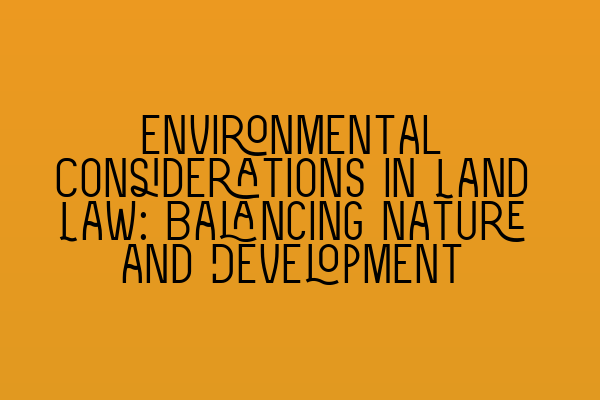Environmental Considerations in Land Law: Balancing Nature and Development
In today’s world, where climate change and environmental concerns are at the forefront of many discussions, it is crucial for property law practitioners to understand and consider the impact of their work on the natural world. Balancing the need for development and progress with sustainable practices and the preservation of nature is an essential aspect of land law.
When dealing with land transactions and property development, it is important to analyze the potential environmental implications. This includes evaluating the impact on ecosystems, biodiversity, and natural resources, as well as compliance with relevant environmental laws and regulations. Failing to consider these factors can lead to legal disputes, negative reputational consequences, and irreparable damage to the environment.
One of the key environmental considerations in land law is the preservation of natural habitats. It is crucial to ensure that development activities do not harm or destroy important ecosystems such as wetlands, forests, or coastal areas. These habitats provide vital services to the environment, including water filtration, carbon sequestration, and support for diverse plant and animal species. An understanding of the legal framework surrounding the protection of these habitats, such as designated Areas of Outstanding Natural Beauty (AONBs) and Sites of Special Scientific Interest (SSSIs), is necessary to ensure compliance and preserve these valuable assets.
Another environmental aspect to consider is the potential pollution caused by development activities. This includes both air and water pollution, noise pollution, and the disposal of hazardous materials. Property law professionals must be knowledgeable about relevant environmental legislation and ensure that their clients follow best practices in waste management, emissions control, and environmentally friendly construction methods. Failure to address these issues can lead to legal liability, fines, and long-term damage to the environment.
Additionally, the preservation of cultural heritage sites should be a priority within land law. These sites hold immense historical and cultural value and often go hand in hand with the natural environment. Property law practitioners need to be aware of any heritage designations and regulations concerning the preservation and restoration of historic buildings, archaeological sites, and conservation areas. This ensures that developments are carried out sensitively and with respect for the cultural significance of the land.
To strike a balance between development and environmental preservation, property law professionals can incorporate sustainable design and construction practices into their work. This can involve the use of renewable energy sources, energy-efficient building materials, and green infrastructures such as rainwater harvesting systems and green roofs. Not only does this contribute to the reduction of carbon emissions and environmental impact but also adds value to the property itself.
In conclusion, environmental considerations are integral to land law, and it is essential for property law practitioners to prioritize the balance between nature and development. Recognizing the importance of preserving natural habitats, addressing pollution concerns, and protecting cultural heritage sites are crucial steps to ensure sustainable and responsible property development. By integrating sustainable practices into their work, property law professionals contribute to a more environmentally conscious society and create a legacy of responsible land use for future generations.
Related Articles:
– SQE 1 Practice Exam Questions
– SQE 1 Practice Mocks FLK1 FLK2
– SQE 2 Preparation Courses
– SQE 1 Preparation Courses
– SRA SQE Exam Dates
